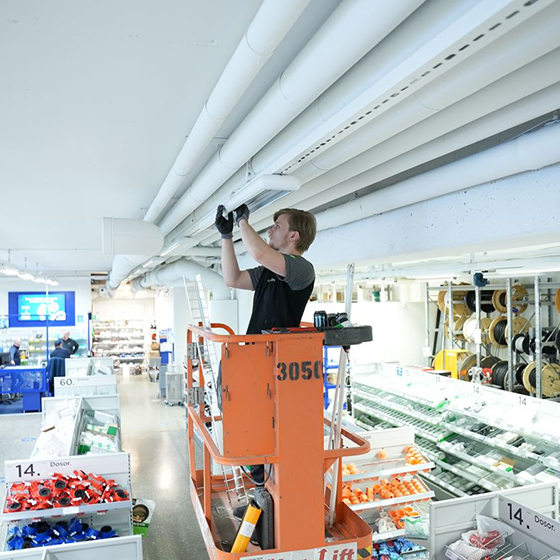The Challenge: 20 million luminaires to be replaced within 5 years
 Energy efficiency is placing high demands on the electricity industry in the EU. In Sweden alone, up to 20 million luminaires are expected to be replaced with more efficient LED alternatives within the next five years. Håkan Pettersson, Technical Lighting Sales Manager at Rexel, notes that: “This is a huge change, and it requires us to act quickly.”
Energy efficiency is placing high demands on the electricity industry in the EU. In Sweden alone, up to 20 million luminaires are expected to be replaced with more efficient LED alternatives within the next five years. Håkan Pettersson, Technical Lighting Sales Manager at Rexel, notes that: “This is a huge change, and it requires us to act quickly.”
No one has missed the fact that the electricity industry is facing a major transition. While there is an ongoing digitalisation and automation of businesses and industries, previously used solutions are expected to be phased out. Rexel specialises in the wholesale distribution of products and services for the electrical industry and is actively working on the transition from older fluorescent tubes to more energy-efficient LED alternatives.
– We provide local expertise and training in connection with the energy transition. From an environmental perspective, this involves cutting down on products containing mercury and older light sources that are not sufficiently efficient. We also assist with the technical inventory of businesses with regard to the conversion processes. It’s important to us that our customers make the correct decisions, which ultimately benefit all parties, Håkan says.
A transition for economic and environmental sustainability
Replacing older lighting with more efficient LED alternatives enables a more cost-effective, sustainable and better quality of light operation. It also optimises energy consumption, freeing up energy for other products and services that need fossil-free energy.
In February 2023, compact fluorescent lamps were phased out and the phasing out of T5 and T8 fluorescent lamps will also begin from August this year. The transition is expected to reduce energy consumption enormously.
– Today, Sweden’s total electricity consumption is 140 TWh per year. Switching to LED alternatives is expected to save up to 5.5 TWh annually in Sweden from 2030, which is a lot. Investing and replacing old lighting frees up huge amounts of energy, enough to meet the needs of 2 million electric cars, for example. Or to make another comparison, it’s roughly equivalent to what a nuclear reactor produces in a year, Håkan says.
Lighting inventory helps prepare for the future
Since many other countries are undergoing a similar transition, there is a growing risk that there will be a lack of both LED options and the right kind of expertise.
–Ours is not the only country in the EU subject to the ban on the import and manufacture of these tubes. The demand for LED alternatives is accelerating, so it is a matter of first come, first served. It’s also important to take into account the need for installers with the right skills. We must think long-term and actively work on skills supply, Håkan says.
He believes that one of the most important keys to making the transition as successful as possible is with a lighting inventory. This makes it possible to document, for preventive purposes, what type of lighting is currently in place, how long it will work and when the time comes to replace it with LED.
– To carry out this transition, it’s important that we do everything in the right order of priorities. We need to perform a risk analysis and set out a possible action plan linked to the older light sources. It will be good if we can let the lamps currently in use burn out, but that means the right spare parts must also be available in the meantime. Otherwise, we need to replace them with LEDs at an even earlier stage. Needs can vary considerably. Some organisations can replace their lighting with LEDs straight away, while others need to make longer-term investments in completely new lighting systems and luminaires, he says.
Inspirational advisers at Elfack
Rexel will show different examples of how the energy transition affects us and the importance of long-term planning on their stand at Elfack, on floor 2.
– We will talk about the results of a long-term investment. We’ll have two concrete examples, both highlighting how the energy transition generates more energy-efficient business. We also want to advise our customers as they begin the implementation of the phase-out process. It’s important to visualise the challenges and opportunities we face, and we hope to do that in our talks and on our stands, Håkan concludes.